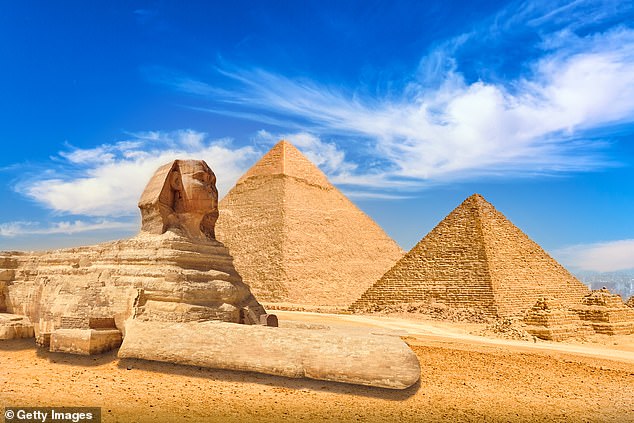New Discoveries Beneath the Giza Pyramids Challenge Established History
Recent findings beneath the Giza Plateau have sparked intense debate among scholars and historians, revealing what could be a vast subterranean complex hidden beneath the iconic pyramids and the Great Sphinx. These discoveries, made by an international team of researchers, suggest that the area may hold secrets far older than previously believed, potentially rewriting the narrative of ancient Egypt.
The research, presented at the recent Cosmic Summit in North Carolina, focuses on advanced geophysical scans that uncovered a massive vertical shaft and two chambers located deep below the base of the Great Sphinx. This discovery has reignited discussions about the possibility of an underground city, with some experts suggesting it could be linked to an ancient civilization that predates known history by tens of thousands of years.
Filippo Biondi, a radar expert from the University of Strathclyde in Scotland, emphasized the significance of the findings. He stated that the scans strongly support the hypothesis that the Giza Plateau conceals a vast subterranean complex, which might indicate an extensive underground city. According to Biondi, the scans revealed a spiral-like staircase leading down into two square structures, one located 2,000 feet below and another 4,000 feet underground.
Armando Mei, an Egyptologist and co-author of the study, noted that similar underground features have been detected beneath all three major pyramids. This suggests a unified architectural blueprint, indicating that the Giza Plateau was engineered long before the dynastic era. Mei’s research proposes that this could date back to around 36,400 BCE, significantly challenging the traditional timeline of ancient Egyptian history.
If confirmed, these findings could dramatically alter our understanding of ancient Egypt. The pyramids, long considered royal tombs, may instead be part of a larger, more complex system that hints at a forgotten civilization with advanced engineering skills. The Giza pyramids and the Great Sphinx are celebrated as marvels of ancient engineering, built roughly 4,500 years ago with precision and scale that continue to baffle experts today.
However, the researchers are challenging this timeline, suggesting that the legendary monuments may rest atop far older, hidden structures. This theory is based on earlier discoveries made in March when the team announced the detection of four massive shafts and chambers under the Pyramid of Khafre using sonar technology. They employed cutting-edge SAR Doppler Tomography, a technique that uses satellite radar to detect tiny seismic movements.
By analyzing radar signals and their timing or pattern when they bounce back, the team created 3D maps revealing hidden subsurface structures. The technology has been published in a peer-reviewed journal, although the latest work by Corrado Malanga from Italy’s University of Pisa, Biondi, and Mei has not yet been published for independent review. They plan to publish a study in 2026.
Biondi explained that their geophysical surveys beneath the Great Sphinx uncovered pillar-like formations similar to those found beneath the Khafre and Menkaure pyramids. Additionally, their tomographic imaging revealed two large chambers nearly 2,000 feet below the surface. The two chambers, each measuring 131 feet by 131 feet, appear to be connected by an underground shaft, according to recent findings.
The data collected also points to a network of hidden structures below the surface, possibly part of a vast underground city, potentially as expansive as the entire Giza Plateau itself. Mei’s theory of a lost city draws from ancient Egyptian texts, particularly Chapter 149 of the Book of the Dead, which references the “14 residences of the city of the dead.” This chapter describes certain chambers and some inhabitants of the city, leading the researchers to believe it could be Amenti, the realm of the dead, as described in ancient texts.
Biondi added that the mysterious chambers found more than 4,000 feet below the pyramids may be linked to the legendary Hall of Records. This mythical chamber is said to lie beneath the Great Pyramid or the Sphinx, reputed to house lost wisdom about ancient civilizations. While there is no solid evidence proving its existence, the researchers propose that an advanced civilization originally built the complex, but was destroyed around 12,000 years ago by a “divine flood” triggered by an asteroid impact.
Alternate historians, including Graham Hancock, have long suggested that a sophisticated prehistoric civilization was wiped out by a global cataclysm, possibly a comet strike. This theory holds that the catastrophic floods and upheaval erased most traces of this civilization, with survivors passing down critical knowledge of astronomy, engineering, and sacred architecture to later cultures such as the ancient Egyptians.
The researchers now hope to gain permission from Egyptian authorities to excavate beneath the Giza Plateau and put their findings to the test, potentially rewriting the story of human history. Biondi emphasized the importance of uncovering the truth, stating, “We have the right. Humanity has the right to know who we are because, right now, we don’t.”







